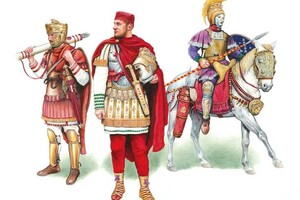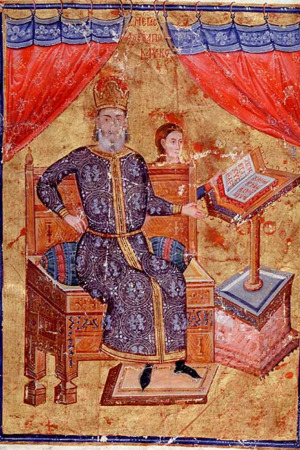Dux
The term "dux" (Latin: dux) had several meanings. In the Roman Republic and later in the Empire, including the Eastern (Byzantine) Empire, it was used to designate a military leader. Later, this term passed into several European languages. In English, the title "duke" corresponded to a duke, while in Italian, the titles "doge" (head of state in Italian maritime republics) and "duce" (leader) were used. In the early Middle Ages, this term was used to designate military leaders among the Lombards, an ancient Germanic tribe that founded the Lombard Kingdom in northern Italy during the Great Migrations. The Lombard Kingdom existed for about two centuries before it was conquered by the Franks.
Republic and Empire
During the time of the Roman Republic, the term "dux" could refer to any military commander, including barbarian ones, but it was not a formal military rank.
The term was first introduced by Gaius Julius Caesar in his "Commentarii de Bello Gallico" when referring to commanders among the Celts. In the Roman Empire until the 3rd century AD, "dux" was not a formal expression of rank in the Roman military or administrative hierarchy. In the Roman army, a dux could be the commander of two or more legions. As a governor, a dux could serve as both a senior civil official and the overall commander of the legions stationed in a given province.
From the mid-3rd century, this term began to acquire a more specific meaning. It started to designate the commanders of vexillationes, which were detachments, usually consisting of one or two cohorts, separated from the legion as an independent force. This occurred in special situations when it was necessary to reinforce a particular direction or section of the border, without sending an entire legion, which would be impractical.
Starting from Emperor Gallienus (reigned 253-268 AD), only a member of the equestrian class with the title "vir perfectissimus" could hold the rank of dux, surpassing the commanders of provincial legions who held the title "vir egregius."
During the Dominate period, the authority of the dux became purely military. They commanded one or several units of the Roman army without being subordinate to the governor of the respective province, who, after the reforms initiated by Diocletian, became a purely civil official.
By the end of the 3rd century, the term "dux" came to denote the highest military commander of the limitanei (frontier troops) in a military district. As part of Diocletian's reforms, the Roman provinces were organized into large units called dioceses. Throughout the 4th and 5th centuries, the structure of the highest military command in the Roman army underwent several changes. Therefore, the following scheme is approximate in nature.
The highest military rank in a diocese was the magister militum (Latin: magister militum), under whom the duxes of the respective military districts served. The dioceses were grouped into several major units known as praetorian prefectures, under the command of praetorian prefects, who were in turn subordinate to the magistri militum of the dioceses within their respective prefectures.
Eastern Roman Empire
In the Eastern Roman Empire (Byzantium), the term "dux" continued to be used to denote a military rank. From the 5th century onward, duxes commanded field armies.
In several provinces of the Eastern Roman Empire, duxes were vested with both military and civilian authority. However, in most cases, duxes functioned solely as military commanders.
By the 7th century, the term "dux" came to denote junior officers, but from the second half of the 10th century, it was again used to designate senior military commanders at the head of military districts during the Late Roman and Early Byzantine empires known as themes. After the 12th century, the term "dux" was used to denote the heads of themes, which were military-administrative districts of the Eastern Roman Empire (Byzantium) created in the mid-7th century to defend the eastern borders of the empire against Arab invasions initially and later against the Seljuk Turks.
In the Notitia Dignitatum, a work of the late 4th or early 5th century that includes a list of the highest military positions in the Roman Empire, there are references to about 25 duxes.
Related topics
Notitia Dignitatum, Dominate, Soldiers of the Roman Empire of the Dominate period, Limitanei
Literature
1. The Oxford Dictionary of Byzantium : [англ.] : in 3 vol. / ed. by Dr. Alexander Kazhdan. — N. Y. ; Oxf. : Oxford University Press, 1991. — P. 659. — ISBN 0-19-504652-8.
2. Dux // The Real Dictionary of Classical Antiquities / author-comp. by F. Lubker; Edited by members of the Society of Classical Philology and Pedagogy F. Gelbke, L. Georgievsky, F. Zelinsky, V. Kansky, M. Kutorgi and P. Nikitin. - St. Petersburg, 1885.




